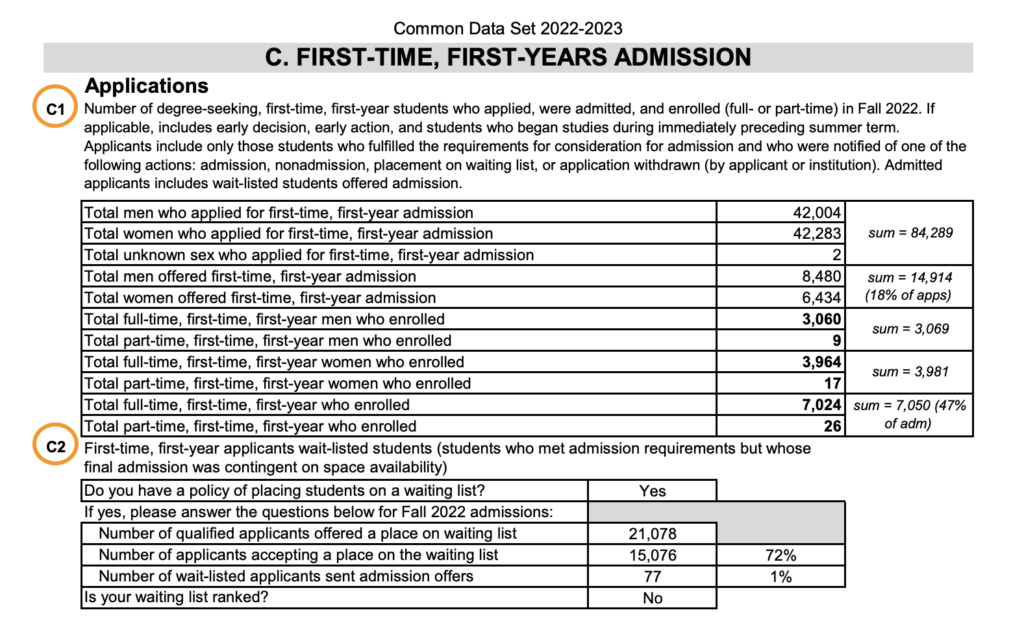When students start looking at colleges, one of the first questions parents ask is, “How much is this going to cost?” Right behind that comes another big one: “What exactly are colleges looking for—and does my kind even have a shot?”
It can all feel overwhelming—but there’s a tool that can help: the Common Data Set.
But what is the Common Data Set, you ask? It’s a detailed report colleges publish every year, filled with facts about admissions, financial aid, and what really matters in the application process. While it may look technical, it’s actually one of the best-kept secrets for students and parents who want honest answers. And the good news? You only need to focus on a few key sections to get the insights that matter most.
What Is the Common Data Set?
The Common Data Set is a report that colleges fill out each year. It has tons of facts about who gets in, how many students apply, what test scores they had, and how much financial aid was given. It even shows what colleges care about most when reviewing applications.
You won’t usually see it on a college’s home page. But it’s public. Just Google the college name and “Common Data Set.” For example:
"University of Michigan Common Data Set"
If you don’t find it right away, look on the admissions or institutional research page of the college’s website.
Why Should You Care?
You don’t have to guess what a college wants. The Common Data Set tells you.
Here’s what you can learn from it:
1. What Colleges Look For in Students
Section C7 of the Common Data Set is where the magic happens.
It lists things like:
- GPA
- Class rank
- Test scores
- Extracurricular activities
- Essays
- Recommendations
Next to each one, the college says whether it’s Very Important, Important, Considered, or Not Considered.
For example, if a college says test scores are Not Considered, you know not to stress about the SAT or ACT. But if essays are Very Important, you should make sure yours stands out.

2. Does the College Care If You’re Interested?
Some colleges want to know that you’re excited about them—and they track it. This is called demonstrated interest, and in the CDS it appears as "Level of Applicant’s Interest" (see above).
If a school ranks this as "Important" or "Very Important," they’re watching to see if you:
-
Open their emails
-
Attend virtual or in-person events
-
Take a campus tour
-
Follow them on social media
-
Reach out to your admissions rep
-
Write a thoughtful “Why Us?” essay (if required)
Why? Because colleges want students who are likely to say yes if offered admission.
Colleges like American University, Rice University, Bates College, and Washington University in St. Louis take this seriously. Check Section C7 to see if your student’s dream school does too.
3. Are Test Scores Required?
Section C8 and C9 show whether a school is test-optional, test-required, or test-blind.
Let’s say you're applying to a test-optional college. If the Common Data Set shows that test scores are still important, and you’ve got a good score—go ahead and send it in. It might help your application.

>>RELATED: College Admissions Guide - How to Apply to College
4. How Competitive Is the College?
In Section C1 and C2, you’ll see how many students applied, how many got in, and how many enrolled.
If 50,000 students applied and only 5,000 were accepted—that’s a 10% acceptance rate. That means it’s a reach school.
But if another school accepts 70% of students, it may be a safer choice.
This helps you build a smart college list with reach, match, and safety schools.

5. What Are the Average GPAs and Class Ranks?
Check Section C10 and C11. These sections tell you what kind of students get accepted.
You’ll see how many had a 4.0 GPA or were in the top 10% of their high school class.
If your grades are similar, that’s a good sign. If not, you may need to look at other schools—or boost other parts of your application.
6. How Much Financial Aid Do Students Get?
This is a big one for parents. Section H of the Common Data Set shows:
- How many students get scholarships
- How much aid students receive
- The average financial aid package
- The average scholarship and grant (free money) awarded
Some expensive schools give lots of aid. Others don’t. The Common Data Set helps you figure that out before you apply.
>>RELATED: How to Choose an Affordable College
One Thing to Know
Most Common Data Sets are a year or two behind. So if you’re applying in Fall 2025, the latest data might be from 2023–24. Some schools' reports are more updated than others.
That’s okay—but double-check the college’s admissions page for any updates. Or contact the admissions rep for your area or your high school counselor. They’ll know if anything has changed.
Final Thoughts
College is a big decision, and it comes with a lot of questions. The Common Data Set gives real answers—like what colleges actually care about in admissions and how much financial aid they tend to give.
So the next time you find yourself wondering what is the Common Data Set, remember this: it’s one of the best free tools for making smarter, more affordable college choices.



